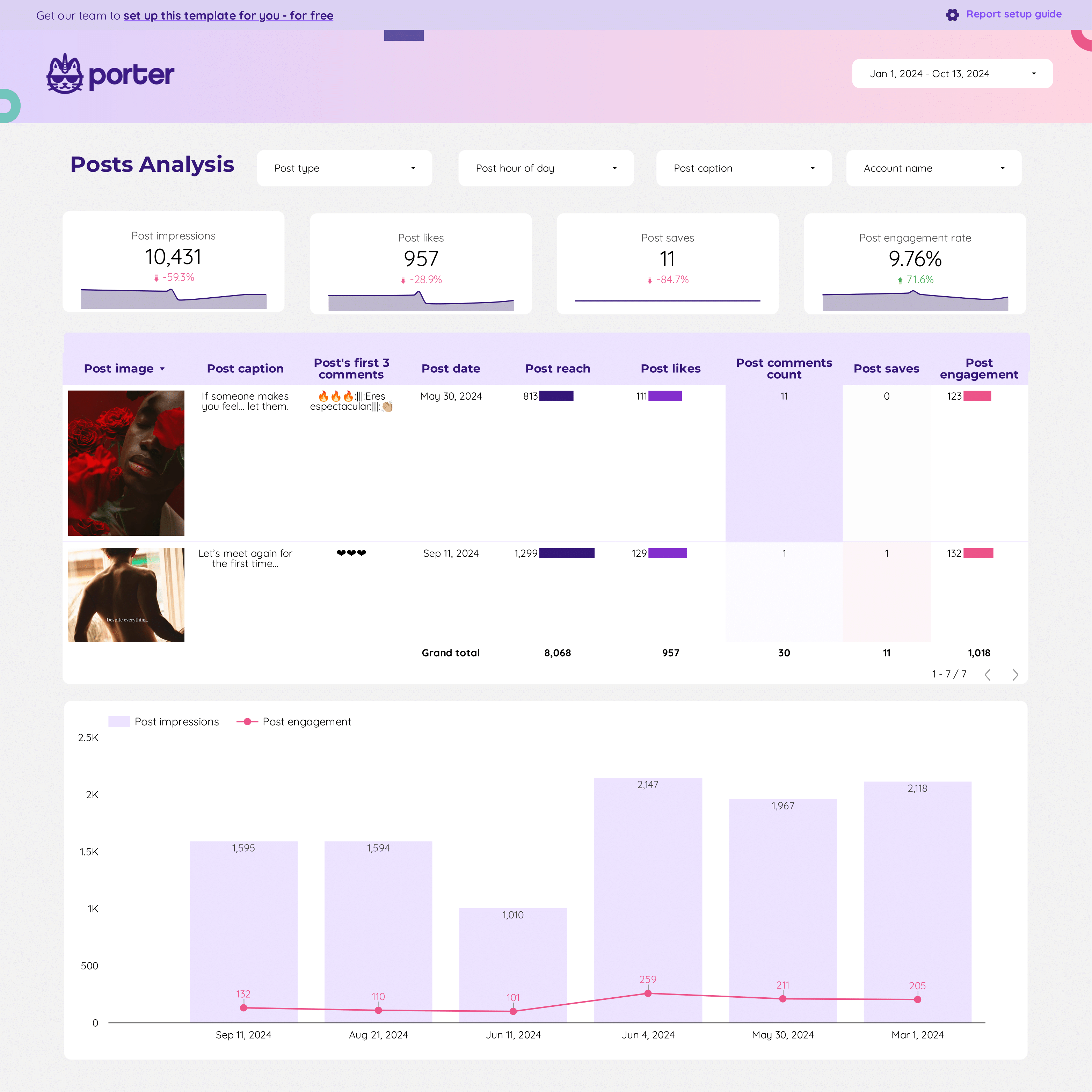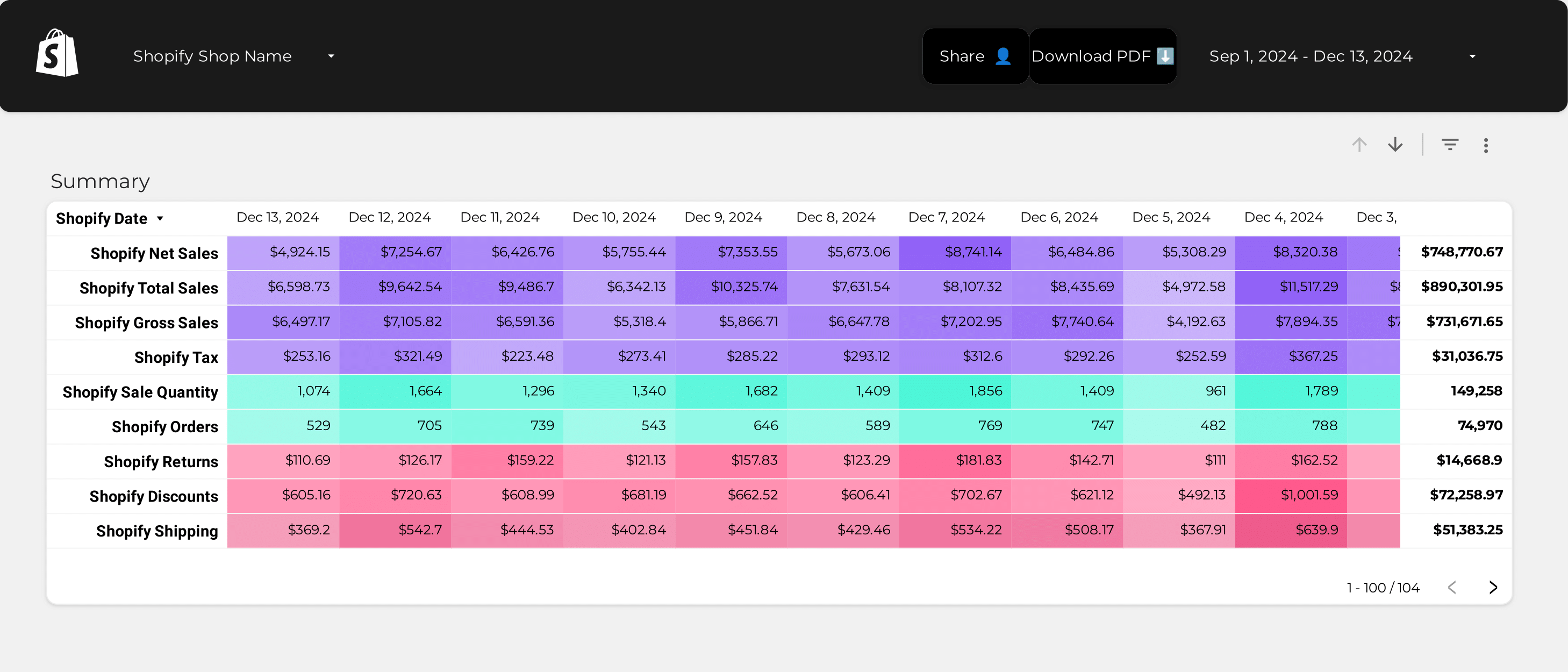What is a KPI report?
A KPI report is a document that consolidates data from multiple sources (e.g., ERP systems, CRM platforms, financial software) to track and display key performance indicators (KPIs) (e.g., revenue growth, customer satisfaction, operational efficiency), enabling teams and executives to monitor organizational performance and create presentations for stakeholders.
KPI reports are typically created using flexible tools like Google Looker Studio, Power BI, Google Sheets, or platform-specific solutions to enable high customization and integration of multiple data sources.
What to include in a KPI report?
An actionable KPI report balances context and specificity based on the audience (executives, managers, and analysts) and their use cases.
Executive KPI reports
Executive reports for CEOs, CFOs, and board members show the organization's bottom-line impact. Reviewed weekly, monthly, or quarterly, they include:
- Financial performance analysis: revenue, profit margins, and cost analysis.
- Customer metrics: customer satisfaction, retention rates, and lifetime value.
- Operational efficiency: productivity metrics, process optimization, and resource utilization.
- Add text for additional context to translate metrics for non-technical audiences. Present in slide decks and simplified Looker Studio reports.
Manager KPI reports
Manager reports have cross-departmental views with drill-downs to see performance by team, project, region, and time period. They help align teams, define strategies, and include:
- Performance tracking: overall project, department, or region performance.
- Goal tracking: compare current performance vs objectives.
- Audits for prioritization and spotting issues.
- Benchmarking for industry and competitive analysis.
- Resource allocation and efficiency analysis.
Operational KPI reports
Operational reports for analysts and department managers have granular, customizable KPIs to solve technical issues. Monitored hourly, daily, or weekly, they cover:
- Production metrics: output rates, defect rates, and downtime.
- Sales metrics: conversion rates, lead times, and sales cycle length.
- Customer service metrics: response times, resolution rates, and customer feedback.
- Supply chain metrics: inventory levels, order fulfillment, and logistics efficiency.
Operational KPI reports are highly customized, built in flexible tools like Google Sheets or Looker Studio to enable data cleaning, blending, annotations, and integrating multiple sources.
How to build a KPI report?
To build a KPI report, connect your data sources, choose a template on Looker Studio or Sheets, build your queries by selecting metrics and dimensions, choose charts to visualize your data, customize the report, design and share via link, PDF or email.
Here’s the breakdown:
Connect data sources
Define and connect the data sources to bring to your report. Common sources are ERP systems for operational data, CRM platforms for customer data, financial software for revenue and cost data, and HR systems for workforce metrics.
To connect your data sources, go to portermetrics.com, choose the data sources to bring to your report.
You can follow these tutorials on connecting your data:
Choose a template
Choose from dozens of KPI report templates in Google Sheets or Looker Studio, designed for use cases like financial analysis, operational monitoring, and customer satisfaction tracking.
Learn to copy Looker Studio templates.
While templates are the starting point, make them specific for your business or organization. Map your specific metrics, especially custom KPIs, CRM data, financial metrics, and all the fields and metrics that you define as "key performance indicators".
Depending on your reporting tool—Google Sheets or Google Looker Studio, pick any of the dozens of templates created by our team and customers to solve your KPI reporting use cases, such as financial analysis, operational monitoring, and customer satisfaction tracking.
Select metrics, dimensions, and charts
Once your report template is downloaded, you may 1)modify it or 2) create a blank page to build it from scratch. Whatever the case, setting up a query always follows these steps:
- Select the data source and the account connected to it
- Choose metrics (e.g., revenue, customer satisfaction, productivity, etc.).
- Choose breakdowns to segment your data (e.g., by date, department, region, etc.)
You can follow these tutorials on adding data to your reports
Design
To make your KPI reports truly white-label you can add logos, colors, fonts, and styling to mirror your brand.
Follow these tutorials to design your KPI reports:
Share
Share your KPI reports via links, PDF, schedule emails, and control permissions.
KPIs to include in a KPI report?
KPI reports should include a mix of financial, operational, customer, and employee metrics to fully understand the performance of the organization towards business goals. They include:
Financial KPIs measure the financial health and performance of the organization:
- Revenue metrics: total revenue, revenue growth, profit margins
- Cost metrics: operational costs, cost of goods sold, overhead expenses
- Profitability metrics: net profit, EBITDA, return on investment
Operational KPIs measure the efficiency and effectiveness of business processes:
- Productivity: output per hour, process efficiency
- Quality: defect rates, error rates
- Utilization: resource utilization, capacity utilization
Customer KPIs measure customer satisfaction and engagement:
- Satisfaction: customer satisfaction score, net promoter score
- Retention: customer retention rate, churn rate
- Engagement: customer engagement score
Employee KPIs measure workforce performance and satisfaction:
- Performance: employee productivity, goal achievement
- Satisfaction: employee satisfaction score, turnover rate
- Development: training hours, skill development
To analyze these KPIs, segment them by:
- Department: sales, operations, finance
- Time: Hourly, daily, weekly, monthly
- Region: branch, country, continent
- Project: phase, milestone, objective
- Customer: demographics, behavior, feedback
- Employee: role, tenure, performance level


